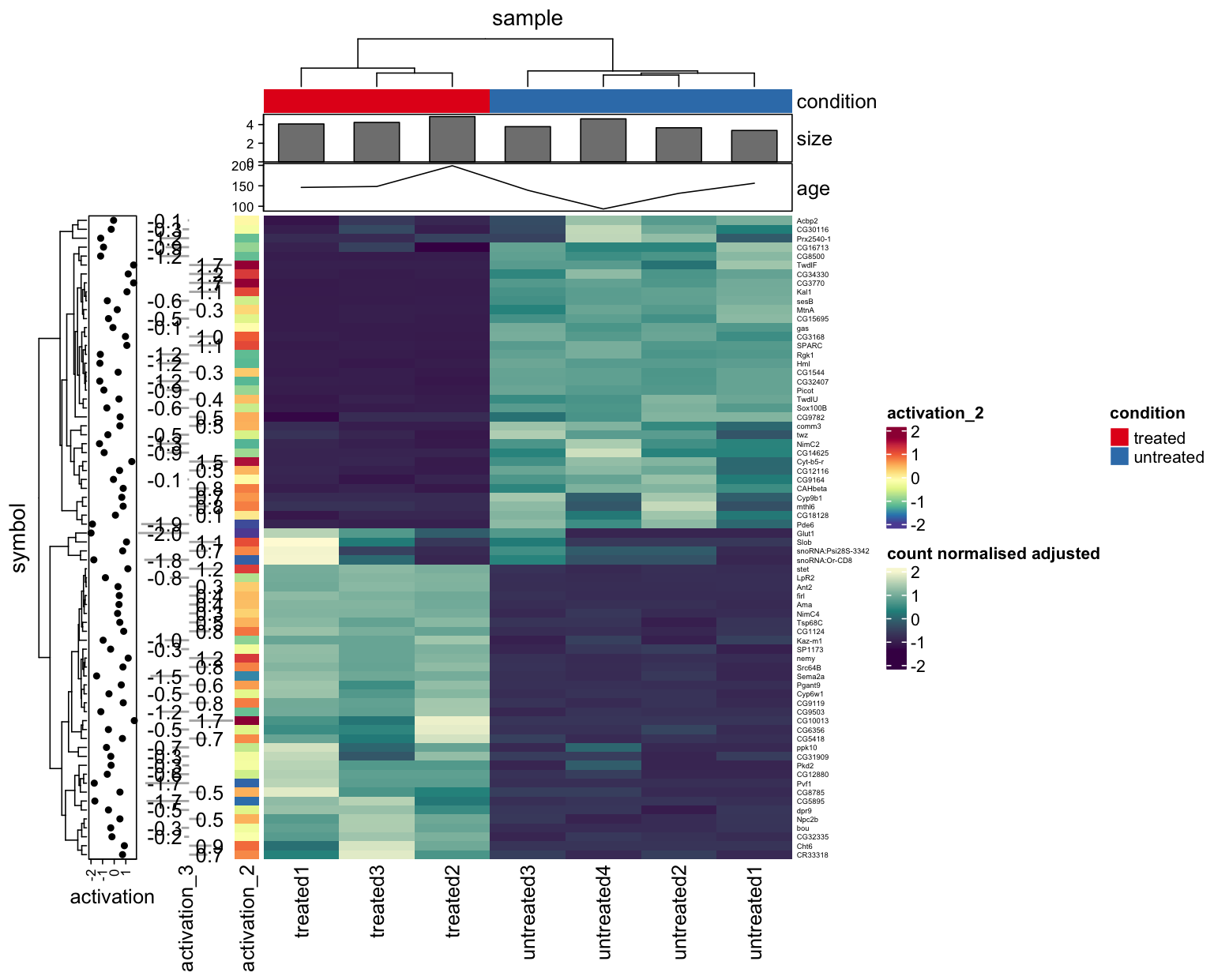
The hardware and bandwidth for this mirror is donated by dogado GmbH, the Webhosting and Full Service-Cloud Provider. Check out our Wordpress Tutorial.
If you wish to report a bug, or if you are interested in having us mirror your free-software or open-source project, please feel free to contact us at mirror[@]dogado.de.
Stefano Mangiola 2025-01-26
tidyHeatmap is a package that introduces tidy principles
to the creation of information-rich heatmaps. This package uses ComplexHeatmap
as graphical engine.
Mangiola et al., (2020). tidyHeatmap: an R package for modular heatmap production based on tidy principles. Journal of Open Source Software, 5(52), 2472, https://doi.org/10.21105/joss.02472
# Create some more data points
pasilla_plus <-
tidyHeatmap::pasilla |>
dplyr::mutate(activation_2 = activation, activation_3 = activation) |>
tidyr::nest(data = -sample) |>
dplyr::mutate(size = rnorm(n(), 4,0.5)) |>
dplyr::mutate(age = runif(n(), 50, 200)) |>
tidyr::unnest(data)
# Plot
pasilla_plus |>
heatmap(
.column = sample,
.row = symbol,
.value = `count normalised adjusted`,
scale = "row"
) |>
annotation_group(location) |>
annotation_tile(condition, show_legend = FALSE) |>
annotation_point(activation) |>
annotation_numeric(activation_3) |>
annotation_tile(activation_2) |>
annotation_bar(size) |>
annotation_line(age)
Advantages:
annotation_group,
e.g. heatmap(...) |> annotation_group(...)After creating a heatmap, you can extract the matrix and dendrograms exactly as they appear in the plot:
# Create heatmap
hm <- tidyHeatmap::N52 |>
tidyHeatmap::heatmap(
.row = symbol_ct,
.column = UBR,
.value = `read count normalised log`
)
# Extract heatmap data as plotted
result <- hm |> get_heatmap_data()
ordered_matrix <- result$matrix # Matrix with rows/columns in heatmap order
row_dendrogram <- result$row_dend # Row dendrogram object
column_dendrogram <- result$column_dend # Column dendrogram object
# All have consistent row and column names
print(rownames(ordered_matrix))
print(labels(row_dendrogram))| Function | Description |
|---|---|
heatmap |
Plots base heatmap |
annotation_group |
Adds group annotation strips and grouping to the heatmap |
annotation_tile |
Adds tile annotation to the heatmap |
annotation_point |
Adds point annotation to the heatmap |
annotation_bar |
Adds bar annotation to the heatmap |
annotation_numeric |
Adds bar + number annotation to the heatmap |
annotation_line |
Adds line annotation to the heatmap |
layer_text |
Add layer of text on top of the heatmap |
layer_point |
Adds layer of symbols on top of the heatmap |
layer_square |
Adds layer of symbols on top of the heatmap |
layer_diamond |
Adds layer of symbols on top of the heatmap |
layer_arrow_up |
Adds layer of symbols on top of the heatmap |
layer_arrow_down |
Add layer of symbols on top of the heatmap |
layer_star |
Add layer of symbols on top of the heatmap |
layer_asterisk |
Add layer of symbols on top of the heatmap |
split_rows |
Splits the rows based on the dendogram |
split_columns |
Splits the columns based on the dendogram |
get_heatmap_data |
Retrieves matrix and dendrograms exactly as plotted |
save_pdf |
Saves the PDF of the heatmap |
+ |
Integrate heatmaps side-by-side |
as_ComplexHeatmap |
Convert the tidyHeatmap output to ComplexHeatmap for non-standard “drawing” |
wrap_heatmap |
Allows the integration with the patchwork package |
To install the most up-to-date version
devtools::install_github("stemangiola/tidyHeatmap")To install the most stable version (however please keep in mind that this package is under a maturing lifecycle stage)
install.packages("tidyHeatmap")If you want to contribute to the software, report issues or problems with the software or seek support please open an issue here
These binaries (installable software) and packages are in development.
They may not be fully stable and should be used with caution. We make no claims about them.
Health stats visible at Monitor.